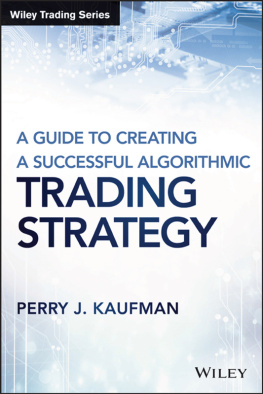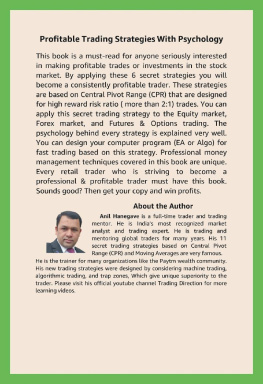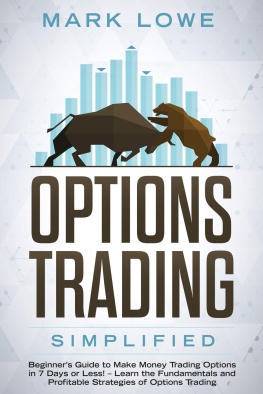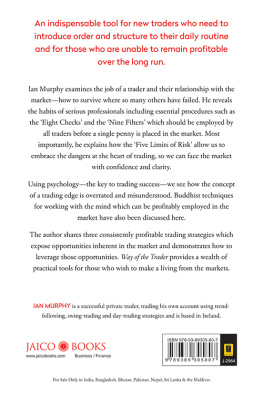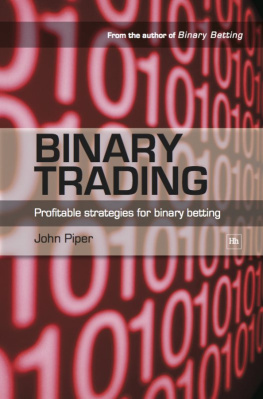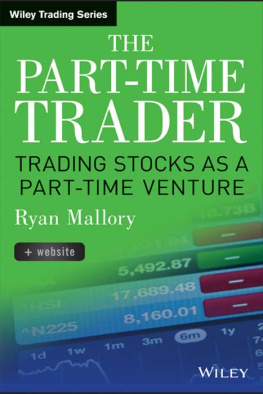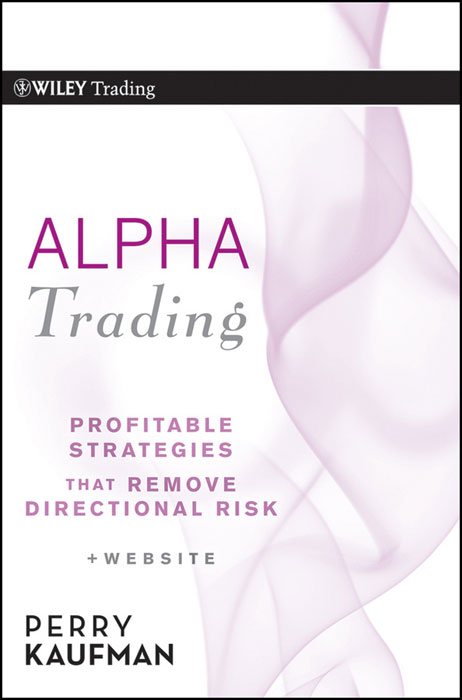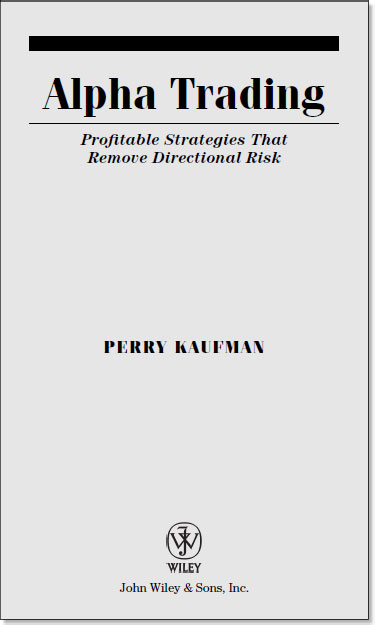Founded in 1807, John Wiley & Sons is the oldest independent publishing company in the United States. With offices in North America, Europe, Australia and Asia, Wiley is globally committed to developing and marketing print and electronic products and services for our customers' professional and personal knowledge and understanding.
The Wiley Trading series features books by traders who have survived the market's ever changing temperament and have prosperedsome by reinventing systems, others by getting back to basics. Whether a novice trader, professional or somewhere in-between, these books will provide the advice and strategies needed to prosper today and well into the future.
For a list of available titles, visit our Web site at www.WileyFinance .com.
Copyright 2011 by Perry Kaufman. All rights reserved.
Published by John Wiley & Sons, Inc., Hoboken, New Jersey.
Published simultaneously in Canada.
No part of this publication may be reproduced, stored in a retrieval system, or transmitted in any form or by any means, electronic, mechanical, photocopying, recording, scanning, or otherwise, except as permitted under Section 107 or 108 of the 1976 United States Copyright Act, without either the prior written permission of the Publisher, or authorization through payment of the appropriate per-copy fee to the Copyright Clearance Center, Inc., 222 Rosewood Drive, Danvers, MA 01923, (978) 750-8400, fax (978) 646-8600, or on the Web at www.copyright.com . Requests to the Publisher for permission should be addressed to the Permissions Department, John Wiley & Sons, Inc., 111 River Street, Hoboken, NJ 07030, (201) 748-6011, fax (201) 748-6008, or online at http://www.wiley.com/go/permissions .
Limit of Liability/Disclaimer of Warranty: While the publisher and author have used their best efforts in preparing this book, they make no representations or warranties with respect to the accuracy or completeness of the contents of this book and specifically disclaim any implied warranties of merchantability or fitness for a particular purpose. No warranty may be created or extended by sales representatives or written sales materials. The advice and strategies contained herein may not be suitable for your situation. You should consult with a professional where appropriate. Neither the publisher nor author shall be liable for any loss of profit or any other commercial damages, including but not limited to special, incidental, consequential, or other damages.
For general information on our other products and services or for technical support, please contact our Customer Care Department within the United States at (800) 762-2974, outside the United States at (317) 572-3993 or fax (317) 572-4002.
Wiley also publishes its books in a variety of electronic formats. Some content that appears in print may not be available in electronic books. For more information about Wiley products, visit our web site at www.wiley.com .
Library of Congress Cataloging-in-Publication Data:
Kaufman, Perry J.
Alpha trading : profitable strategies that remove directional risk / Perry Kaufman.
p. cm. (Wiley trading series)
Includes index.
ISBN 978-0-470-52974-4 (cloth); ISBN 978-1-118-00120-2 (ebk);
ISBN 978-1-118-00121-9 (ebk); ISBN 978-1-118-00122-6 (ebk)
1. Pairs trading. 2. Futures. I. Title.
HG4661.K33 2011
332.6452dc22
2010032753
Preface
I wanted to write this book after the collapse of the tech bubble in 2000, but it wasnt until the subprime disaster of 2008 that I decided to do it. Investors should not be subject to the tremendous losses that the market serves up. And traders do not need to make a commitment to a long or short position all the time. There are other choices, and those choices do not necessitate compromising returns. They do require somewhat more complicated positions, but the reward is that, if the S&P collapses because of a terrorist attack, or program trading by one of the big investments houses runs amok and causes a 10 percent drop in the S&P, you are safe.
Weve learned greater respect for risk in the past few years. Its a lesson that we all should have learned much sooner, but any time is a good time to improve your skills. Part of that advancement is to be aware of unconscious risks. When we trade more than one stock, each trade should have equal risk. That gives each trade an equal opportunity to contribute to the final results. If you dont do that, you are consciously or unconsciously saying that you think the trade with the largest risk is most likely to give you the best return. If thats the case, you should only make one trade in the best item and forget about diversification.
This book is as much about the process as it is about the results. Its target audience is active traders but not necessarily intraday traders. The intended reader is someone who spends time deciding which stocks or futures markets to buy or sell and doesnt hold a trade indefinitely when it goes the wrong way. Each step is explained, and there are examples of how the numbers should look. There is also a website that has the basic spreadsheets needed to do all the calculations.
The strategies in this book are well known to be profitable. They are called statistical arbitrage, or stat-arb, and they can be traded by holding positions for a few days, as suggested here, or for milliseconds, as implemented by the big investment houses. To trade, all you need is a spreadsheet to do a few calculations; then enter prices at the end of the day or anytime during the day when you think there is an opportunity. Trades have a high probability of success.
You cannot just believe that something works; you need to prove it to yourself. The black box approach is unacceptable and has proved a disaster to many investors. Its your money, and you owe it to yourself to understand and verify everythingeven what is shown in this book.
It is one thing to be given a strategy and another to use it successfully. Once you have verified and paper-traded the strategies, you have a better chance of being successful because you have become part of the development process.
The development process is an exciting exploration. It begins with a sound premise and moves down various paths that may or may not turn out to be useful. But at the same time, it teaches valuable lessons. You understand why one idea works and another doesnt. You understand the robust and the fragile parts of the strategies. At some time in the future, you may be called upon to change the strategy because the market has changedvolatility has dropped to a level that limits opportunity or risen to a point of unacceptable risk. Markets that used to move together no longer do so, or as in the fourth quarter of 2008, markets moved together for no apparent reason.
Without having gone through the process, you do not have the knowledge to make these changes or the confidence that they will work. This book will present important strategies that should be part of any traders portfolio. It will develop and explain the features that are incorporated, as well as choices that were not taken. But it is the sound premise of these ideas that is the underlying reason for its success. At the end, I hope you have learned a lot and that you trade successfully.
Perry Kaufman
January 2011
Chapter 1
Uncertainty
The investment world had a rude reminder in August and September of 2008 that forecasts and risk have more uncertainty than it would like to believe. From August 28 to the following March 9, the Standard & Poor's (S&P) 500 dropped 47%. Even more remarkable was that every investment was dragged down with ithedge funds that were expected to offer diversification, commodity funds where you have the security of so-called hard currency, real estate, art, and of course, every possible stock in nearly every country.


